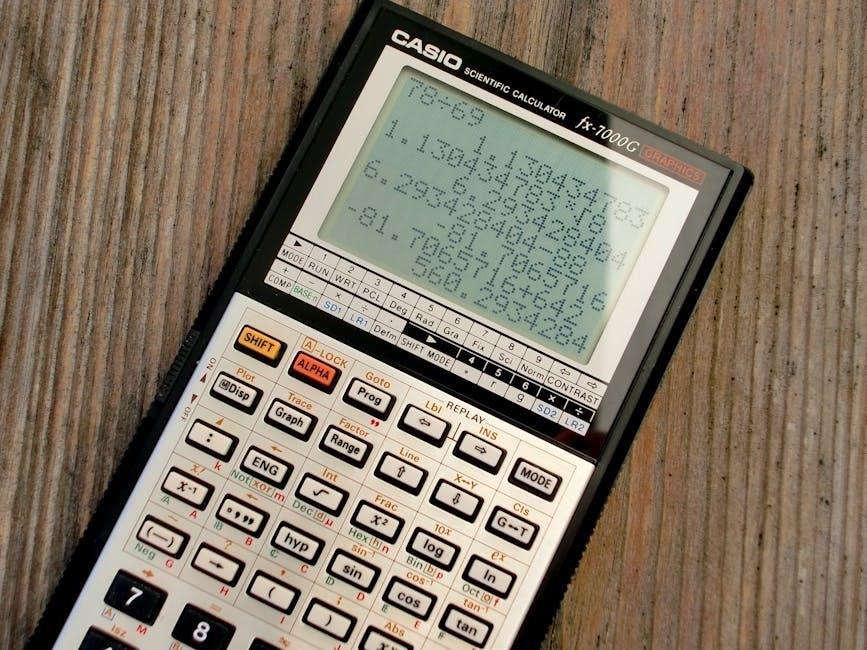Math operations key words are essential for understanding basic arithmetic. They help identify operations in word problems, such as sum for addition or minus for subtraction. Mastering these terms builds a strong foundation for solving problems and algebraic expressions, covering addition, subtraction, multiplication, and division.
1.1 Importance of Key Words in Math Operations
Math operations key words are crucial for identifying and interpreting arithmetic processes in word problems. These terms guide students in determining whether to add, subtract, multiply, or divide. Recognizing key words like sum, minus, or product helps in setting up correct equations. They act as clues, enabling learners to translate written language into mathematical expressions. Mastering these words enhances problem-solving skills and builds a strong foundation for algebra. Key words also aid in understanding inverse operations, such as how addition and subtraction relate. By focusing on these terms, students can better decode mathematical language, making problem-solving more systematic and accurate. This skill is vital for progressing in mathematics, as it simplifies complex word problems into manageable arithmetic tasks.
1.2 Brief Overview of Basic Math Operations
Basic math operations form the foundation of arithmetic and include addition, subtraction, multiplication, and division. Addition involves combining two or more numbers to find their total, often indicated by words like sum or altogether. Subtraction is the process of finding the difference between numbers, typically signaled by terms like minus or take away. Multiplication is repeated addition, commonly represented by product or times, while division involves splitting a number into equal parts, often denoted by quotient or split. These operations are essential for solving word problems and forming algebraic expressions. Understanding them helps learners decode mathematical language and apply the correct processes. Each operation has unique key words and phrases that act as clues, making them vital for accurate problem-solving. Grasping these basics is crucial for advancing in mathematics.

Addition Key Words
Addition key words help identify when to combine numbers. Common terms include sum, add, total, increase, more than, altogether, and plus. These words signal the need for addition in problems.
2.1 Common Addition Key Words
Common addition key words are terms that indicate the need to combine numbers or quantities. These words include sum, add, total, increase, more than, altogether, and plus. For example, the word sum suggests adding numbers together, while total refers to the overall amount after combining. Add and plus are direct indicators of addition operations. Understanding these key words helps in translating word problems into mathematical expressions. They are fundamental for building a strong grasp of arithmetic and algebraic expressions. These terms are often highlighted in math vocabulary cards and worksheets to reinforce their recognition and application. Mastering these key words enables students to approach addition problems with confidence and accuracy.
2.2 Phrases Indicating Addition
Certain phrases in word problems signal the need for addition. Common examples include “how many in all”, “combined”, “more than”, and “greater than”. These phrases often appear in contexts where two or more quantities are being merged or compared. For instance, “how many in all” suggests adding two groups together to find the total. Similarly, “more than” indicates an increase, which requires addition. Other phrases like “altogether” or “increased by” also point to addition operations. Recognizing these phrases is crucial for translating word problems into mathematical expressions. They help students identify when to use addition to find the solution. These phrases are widely used in math resources and templates to practice identifying addition operations effectively.

Subtraction Key Words
Subtraction key words include terms like minus, less than, difference, fewer than, and subtracted by. These words signal the need to find the difference between numbers.
3.1 Common Subtraction Key Words
Subtraction key words are terms that indicate the need to find the difference between numbers. Common key words include minus, less than, difference, and fewer than. For example, the word minus directly represents subtraction, while less than signals comparing two quantities. The term difference is often used to imply subtraction in word problems, such as “What is the difference between 15 and 8?” Additionally, phrases like subtracted by or reduced by also indicate subtraction. These words help students identify when to use the subtraction operation in mathematical problems. Recognizing these key words is crucial for accurately solving word problems and understanding algebraic expressions. Mastering subtraction vocabulary enhances problem-solving skills and builds a strong foundation in arithmetic.
3.2 Phrases Indicating Subtraction
Certain phrases in word problems signal the need for subtraction. For example, “how many are left” or “how much less” indicates a subtraction operation. Phrases like “the difference between” or “take away” also suggest subtraction. For instance, the phrase “more than” in a problem like “5 more than 3” implies subtracting to find the difference. Additionally, phrases such as “subtracted by” or “reduced by” clearly indicate subtraction. These phrases help students recognize when to apply the subtraction operation. Recognizing such language is crucial for accurately interpreting and solving word problems. By identifying these phrases, learners can better understand when subtraction is required, enhancing their ability to translate words into mathematical expressions. Mastering these phrases strengthens problem-solving skills and math fluency.

Multiplication Key Words
Multiplication key words include times, product, groups of, and each. These terms help identify multiplication in word problems, aiding in setting up correct mathematical expressions for solutions.
4.1 Common Multiplication Key Words
Multiplication key words are crucial for identifying when to use the multiplication operation in word problems. Common terms include times, product, groups of, and each. These words often signal that a multiplication operation is required. For example, the word times directly indicates multiplication, while groups of suggests repeated addition. Other phrases like each or multiplied by also point to multiplication. Understanding these keywords helps in translating word problems into mathematical expressions accurately. For instance, “5 groups of 4” translates to 5 × 4. Recognizing these terms is essential for solving multiplication-based problems effectively and ensures a strong foundation in arithmetic operations. These keywords are widely used in educational resources and practice materials to help learners master multiplication concepts.
4.2 Phrases Indicating Multiplication
Certain phrases in word problems often signal the need for multiplication. Common examples include “in all”, “how many times”, “multiple of”, and “repeated addition”; These phrases suggest that a quantity is being added multiple times or scaled up. For instance, the phrase “how many times more” indicates a multiplicative relationship. Similarly, “repeated addition” directly refers to the concept of multiplication. Understanding these phrases is vital for translating word problems into mathematical expressions accurately. They help identify when to use multiplication in real-world scenarios, such as calculating the total number of items in multiple groups. Mastery of these phrases enhances problem-solving skills and builds confidence in handling multiplication-based challenges. These indicators are widely used in educational materials to assist learners in recognizing multiplication operations effectively.

Division Key Words
Division key words help identify when to divide in word problems. Common terms include “divided by”, “split”, “share equally”, and “how many per”. These phrases indicate the need for division, aiding in translating problems into mathematical expressions.
Examples like “divided by” or “split” suggest equal distribution, making division operations clear and manageable for learners of all levels.
5.1 Common Division Key Words
Division key words are phrases or terms that indicate the need for division in a mathematical problem. Common division key words include “divided by”, “split”, “shared equally”, “how many per”, and “among”. These terms often signal that a quantity is being distributed equally or separated into smaller parts. For example, phrases like “divided by” or “split” suggest dividing a whole into equal groups. Other terms like “how many per” or “among” imply determining the number of items each person or group receives; Recognizing these key words is essential for translating word problems into mathematical expressions. They help learners understand when to use division to find solutions. Mastery of these terms builds confidence in solving real-world problems involving distribution, grouping, or equal sharing.
5.2 Phrases Indicating Division
Certain phrases in word problems signal the need for division. Common examples include “divided by”, “split”, “shared equally”, “how many per”, and “among”. These phrases suggest dividing a quantity into equal parts or groups. For instance, “divided by” or “split” indicate separating a whole into smaller, equal sections. Phrases like “shared equally” or “among” imply distributing items fairly among people or groups. Additionally, “how many per” often refers to determining the number of items each person receives. Recognizing these phrases is crucial for translating word problems into division operations. They guide learners in identifying when to divide to find a solution. Understanding these phrases enhances problem-solving skills, especially in real-world scenarios involving distribution or equal sharing.

Inverse Operations
Inverse operations are pairs of math operations that reverse each other’s effects. Addition and subtraction are inverses, as are multiplication and division. They are essential for solving equations and checking answers.
6.1 Addition and Subtraction as Inverse Operations
Addition and subtraction are fundamental inverse operations, meaning they undo each other. For example, if you add 5 to a number, subtracting 5 returns it to its original value. Understanding this relationship helps in solving equations and simplifying expressions. Key words like sum, total, and more than indicate addition, while difference, less than, and take away signal subtraction. These operations are crucial for word problems and real-world applications, as they represent combining or separating quantities. Mastery of these inverses builds a strong math foundation and enhances problem-solving skills.
6.2 Multiplication and Division as Inverse Operations
Multiplication and division are inverse operations, meaning they reverse each other’s effects. For instance, multiplying 4 by 5 gives 20, while dividing 20 by 5 returns to 4. Key words like product, times, and groups of indicate multiplication, whereas quotient, split into, and how many for each signal division. Understanding these operations is vital for solving real-world problems and algebraic expressions. They represent scaling up or down in quantity, making them essential for word problems involving grouping or sharing. Mastery of these inverses enhances problem-solving skills and builds a robust foundation in mathematics.

Symbols in Math Operations
Symbols like +, -, ×, and ÷ are fundamental in math. They represent addition, subtraction, multiplication, and division, playing a crucial role in algebraic expressions and solving equations.
7.1 Common Symbols Used in Math Operations
Math operations rely on specific symbols to represent actions. The + symbol denotes addition, while the — symbol stands for subtraction. Multiplication is represented by × or ×, and division by ÷ or / . The = sign indicates equality, showing the result of an operation.Parentheses ( ) are used to group numbers and prioritize operations. These symbols are universal, making math communication consistent across languages and regions. Understanding them is vital for solving equations and algebraic expressions. They provide clarity and precision, enabling accurate problem-solving in arithmetic and higher-level mathematics. Mastering these symbols is foundational for all math operations.
7.2 Importance of Symbols in Algebraic Expressions
Symbols play a crucial role in algebraic expressions by providing clarity and precision. They replace words, making equations concise and universal. Common symbols include + (addition), ⎻ (subtraction), × (multiplication), and ÷ (division). The = sign denotes equality, while ( ), { }, and [ ] organize complex expressions. Symbols like ^ (exponentiation) and √ (square root) represent advanced operations. These symbols allow combining numbers, variables, and constants into expressions and equations. They ensure operations are performed in the correct order, avoiding ambiguity. For example, 3 × (2 + 4) clearly indicates addition inside parentheses first. Without symbols, algebraic expressions would be unclear and difficult to interpret. Thus, symbols are foundational to algebra and higher mathematics, enabling precise communication of mathematical ideas.

Application in Word Problems
Key words in word problems guide operation selection. Terms like sum indicate addition, while minus suggests subtraction. These cues help translate phrases into equations for solutions.
8.1 Using Key Words to Identify Operations
Identifying key words in word problems is crucial for determining the correct mathematical operation. Words like sum, total, and altogether often indicate addition. For example, “The sum of two numbers is 10” suggests adding two values. Similarly, terms like minus, difference, and take away signal subtraction, as in “Subtract 5 from 15.”

Multiplication is often implied by words like times, product, or groups of. For instance, “5 groups of 4 apples” means multiplying 5 and 4. Division key words include divide, share, or split, such as “Divide 12 candies among 4 children.”
Recognizing these key words helps translate word problems into mathematical expressions. However, it’s important to read carefully, as some phrases might imply operations indirectly. For example, “twice as many” suggests multiplication, while “half of” indicates division. Mastering this skill enhances problem-solving accuracy and builds confidence in tackling complex word problems effectively.
8.2 Steps to Solve Word Problems
Solving word problems involves a systematic approach to ensure accuracy. First, read the problem carefully and identify the key words that indicate the operation needed, such as sum for addition or divide for division. Next, highlight or underline these key terms to focus on the essential information.
Then, translate the words into a mathematical expression using numbers, symbols, and variables. For example, “The total of 15 and 7” becomes (15 + 7). After setting up the equation, perform the calculation to find the solution.
Finally, check the answer by substituting it back into the original problem to ensure it makes sense. This step-by-step method helps break down complex problems into manageable parts, ensuring clarity and precision in solving them effectively.
8.3 Common Mistakes in Interpreting Key Words
One of the most frequent errors when interpreting key words in math problems is misidentifying the operation. For example, words like “sum” and “total” clearly indicate addition, but phrases like “twice as many” might confuse some, as they suggest multiplication rather than addition. Another common mistake is overlooking context, such as interpreting “less than” as subtraction without considering the order of numbers. Additionally, similar-sounding words can lead to confusion, like mistaking “minus” for “minus sign” or “difference” for “division.”
Students often struggle with multi-step problems, where multiple key words might imply more than one operation. For instance, “a number increased by 5 and then divided by 3” requires careful interpretation to apply the correct sequence of operations. These misunderstandings highlight the importance of careful reading and practice to avoid errors in translating words into mathematical expressions.

PDF Resources and Templates
Math operations key words PDFs offer comprehensive resources, including math vocabulary cards and worksheet templates. These tools cover addition, subtraction, multiplication, and division, helping students practice and master key terms effectively.
9.1 Math Vocabulary Cards for Key Words
Math vocabulary cards are an excellent resource for teaching and learning key words related to math operations. These cards typically include terms like sum, difference, product, and quotient, along with their corresponding symbols and definitions. They are designed to help students memorize and understand the language of mathematics, making it easier to identify operations in word problems. Each card often features a key word on one side and its definition or symbol on the other, encouraging active recall and repetition. Many sets of vocabulary cards are available in PDF format, allowing teachers and parents to print and customize them for different learning needs. These cards are particularly useful for visual learners, as they provide a clear and concise way to review essential math terminology. By mastering these key words, students can improve their ability to translate word problems into mathematical expressions and solve them confidently.
9.2 Worksheet Templates for Practice
Worksheet templates are invaluable tools for practising math operations key words. They provide structured exercises that help students reinforce their understanding of addition, subtraction, multiplication, and division. Many templates include activities such as matching key words to their corresponding symbols, filling in the blanks with the correct operation, or solving word problems. These exercises are designed to be engaging and educational, ensuring students grasp the connection between language and math operations.
Templates often feature a variety of formats, such as multiple-choice questions, true/false statements, or short-answer sections. They may also include visual aids like charts or diagrams to enhance learning. Additionally, some worksheets focus on identifying inverse operations, helping students understand the relationship between addition and subtraction, or multiplication and division.
The best part is that these templates are widely available in PDF format, making them easy to download, print, and distribute. Many resources offer customizable options, allowing educators to tailor activities to specific learning needs. With consistent practice using these templates, students can master math operations key words and improve their problem-solving skills.
Mastering math operations key words is essential for solving arithmetic problems effectively. These terms provide a clear foundation for understanding addition, subtraction, multiplication, and division, aiding in word problems and algebraic expressions.
10.1 Summary of Key Points
Understanding math operations key words is fundamental for solving arithmetic problems. These terms guide the identification of operations like addition, subtraction, multiplication, and division. Key words such as sum, minus, product, and quotient simplify problem-solving. Inverse operations, like addition and subtraction, are crucial for checking solutions. Common phrases, such as total of or how many in all, indicate specific operations. Vocabulary cards and practice templates are invaluable resources for mastering these terms. Recognizing these words helps in translating word problems into algebraic expressions. Avoiding mistakes, such as confusing greater than with subtraction, is essential. Regular practice with worksheets and real-world applications reinforces these concepts. By mastering math operations key words, learners build a strong foundation for advanced mathematics. These terms are the cornerstone of problem-solving, enabling accurate interpretation and execution of arithmetic tasks.
10.2 Future Directions in Learning Math Operations
Mastering math operations key words is just the beginning. Future learning should focus on applying these terms to complex word problems and real-world scenarios. Integrating technology, such as interactive apps and gamified platforms, can enhance engagement and understanding. Developing fluency in identifying operations quickly and accurately is crucial. Encouraging the use of visual aids, like charts and diagrams, can deepen comprehension. Collaborative learning, where students explain their reasoning, fosters critical thinking. Advanced topics, such as algebra and word problem-solving, will naturally follow as students become proficient. Regular practice with updated worksheets and digital tools will reinforce these skills. By connecting math operations to practical applications, learners will appreciate the relevance of key words in everyday life. This foundational knowledge will serve as a springboard for tackling higher-level mathematics with confidence and precision.
Leave a Reply
You must be logged in to post a comment.